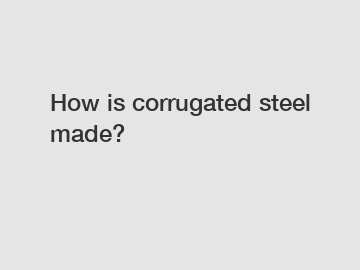How is corrugated steel made?
How is Corrugated Steel Made?
Corrugated steel is a versatile building material known for its strength, durability, and ability to withstand harsh environmental conditions. It is commonly used in the construction of roofs, walls, fences, and other structures. But how is corrugated steel made? In this article, we will explore the process of manufacturing corrugated steel, from raw materials to the finished product.
Raw Materials and Steel Production.

The first step in making corrugated steel is obtaining the necessary raw materials. Steel is the primary component, and it is typically sourced from iron ore. The iron ore undergoes a series of processes, such as smelting and refining, to extract the iron and transform it into steel. Once the steel has been produced, it is sent to a rolling mill.
Rolling Process.
At the rolling mill, the steel is heated and passed through a series of rollers under tremendous pressure. This process, known as hot rolling, gives the steel its desired thickness and shape. The hot rolled steel is then cooled and cut into sheets.
Corrugation Formation.
To create the characteristic corrugated shape, the sheets of steel are fed into a corrugating machine. The machine has a series of specially designed rollers that create the ridges and valleys on the surface of the steel. The dimensions and spacing of these corrugations can vary depending on the intended use of the corrugated steel.
Galvanization.
After the corrugations are formed, the steel sheets may undergo a galvanization process. This involves coating the steel with a layer of zinc to protect it from corrosion. The zinc coating, commonly known as galvanizing, acts as a sacrificial barrier, preventing the steel from coming into contact with oxygen and moisture that can cause rust. Galvanizing also enhances the aesthetic appeal of the corrugated steel by giving it a shiny, metallic finish.
Cutting and Shaping.
Once the galvanized steel sheets are ready, they are cut to the desired length and shape. This can be done using different cutting techniques such as shearing or sawing. The cut sheets are then ready to be used for various applications, including roofing, siding, and fencing.
Benefits of Corrugated Steel.
Corrugated steel offers numerous benefits that make it a popular choice in the construction industry. Its strength and durability make it resistant to impacts, extreme weather conditions, and fire. Additionally, the ridges and valleys formed during the corrugation process add stiffness to the steel, increasing its load-bearing capacity. Corrugated steel is also lightweight, which makes it easier to handle and transport.
Conclusion.
In conclusion, the process of making corrugated steel involves several stages, from sourcing raw materials to forming the characteristic corrugations and applying protective coatings. The result is a versatile and durable building material that can be used in a wide range of applications. Whether it's for roofing, walls, or fences, corrugated steel provides the strength and durability needed for long-lasting structures. If you are interested in purchasing corrugated steel or have any further questions, please do not hesitate to contact us.
If you are looking for more details, kindly visit galvanized and galvalume difference, carbon steel wirerods, corrugated steel plates supplier.
149
0
0


Comments
All Comments (0)